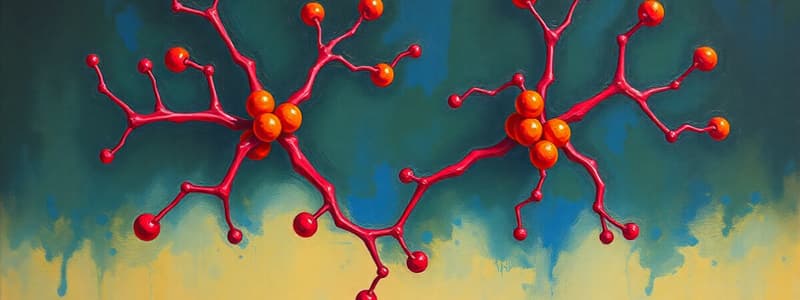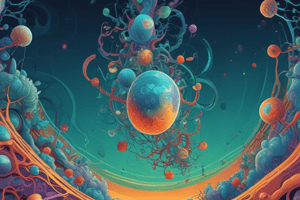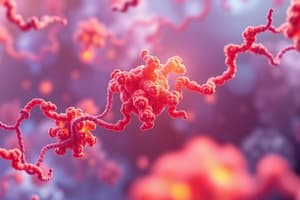Podcast
Questions and Answers
What is the primary function of Receptor Tyrosine Kinases (RTKs)?
What is the primary function of Receptor Tyrosine Kinases (RTKs)?
- To transport ions across the cell membrane in response to ligand binding.
- To directly regulate gene transcription within the nucleus.
- To mediate the actions of polypeptide and protein hormones, as well as growth factors. (correct)
- To serve as structural components of the cell membrane.
All enzyme-linked receptors possess intrinsic enzymatic activity within their intracellular domains.
All enzyme-linked receptors possess intrinsic enzymatic activity within their intracellular domains.
False (B)
The binding of a ligand to a receptor tyrosine kinase (RTK) leads to ________ of the receptor monomers, initiating a cascade of events.
The binding of a ligand to a receptor tyrosine kinase (RTK) leads to ________ of the receptor monomers, initiating a cascade of events.
dimerization
Match the following EGFR-targeted anticancer therapies with their mechanisms of action:
Match the following EGFR-targeted anticancer therapies with their mechanisms of action:
Which of the following is a direct consequence of the activation of the RAS/MAPK pathway by EGFR signaling?
Which of the following is a direct consequence of the activation of the RAS/MAPK pathway by EGFR signaling?
Cytokine receptors possess intrinsic tyrosine kinase activity, similar to receptor tyrosine kinases (RTKs).
Cytokine receptors possess intrinsic tyrosine kinase activity, similar to receptor tyrosine kinases (RTKs).
Explain the role of JAKs in the activation of STATs following cytokine receptor binding.
Explain the role of JAKs in the activation of STATs following cytokine receptor binding.
Following phosphorylation by JAKs, STAT proteins ________ to form dimers, which then translocate to the nucleus.
Following phosphorylation by JAKs, STAT proteins ________ to form dimers, which then translocate to the nucleus.
Match the following JAK inhibitors with the diseases they are used to treat:
Match the following JAK inhibitors with the diseases they are used to treat:
Which of the following events is crucial for initiating the PI3K/AKT signaling pathway downstream of receptor tyrosine kinases (RTKs)?
Which of the following events is crucial for initiating the PI3K/AKT signaling pathway downstream of receptor tyrosine kinases (RTKs)?
The primary role of the SH2 domain in the RAS/MAPK pathway is to directly activate RAS GTPase.
The primary role of the SH2 domain in the RAS/MAPK pathway is to directly activate RAS GTPase.
Describe the structural components that are typical of EGFRs, and how these components contribute to receptor activation and signaling.
Describe the structural components that are typical of EGFRs, and how these components contribute to receptor activation and signaling.
Dysregulation of the EGF/EGFR pathway, such as through mutation or overexpression, is a key factor in the development of ________.
Dysregulation of the EGF/EGFR pathway, such as through mutation or overexpression, is a key factor in the development of ________.
Match the following components of the JAK/STAT signaling pathway with their primary function:
Match the following components of the JAK/STAT signaling pathway with their primary function:
Why is receptor dimerization crucial for the activation of receptor tyrosine kinases (RTKs)?
Why is receptor dimerization crucial for the activation of receptor tyrosine kinases (RTKs)?
Tyrosine kinase inhibitors (TKIs) directly enhance the activity of ATP to promote downstream signaling.
Tyrosine kinase inhibitors (TKIs) directly enhance the activity of ATP to promote downstream signaling.
Explain how the internalization of ligands by RTKs ultimately impacts the cellular response.
Explain how the internalization of ligands by RTKs ultimately impacts the cellular response.
The activated transcription/translation produces ________ that mediate immune responses & inflammation > completion of the inflammation feedback loop.
The activated transcription/translation produces ________ that mediate immune responses & inflammation > completion of the inflammation feedback loop.
Match the following.
Match the following.
Flashcards
Receptor Superfamily
Receptor Superfamily
Group of receptors sharing a similar basic molecular structure and utilizing the same signal transduction pathway.
Enzyme-linked receptors
Enzyme-linked receptors
Receptors that either have intrinsic enzymatic activity or associate directly with intracellular enzymes.
Receptor Tyrosine Kinases (RTKs)
Receptor Tyrosine Kinases (RTKs)
A family of cell-surface receptors mediating the actions of polypeptide, protein hormones, and growth factors.
EGFR structure
EGFR structure
Signup and view all the flashcards
Dimerization of EGFRs
Dimerization of EGFRs
Signup and view all the flashcards
EGFR Signalling Pathways
EGFR Signalling Pathways
Signup and view all the flashcards
Grb2 in RAS/MAPK pathway
Grb2 in RAS/MAPK pathway
Signup and view all the flashcards
JAK (Janus Kinase)
JAK (Janus Kinase)
Signup and view all the flashcards
STATs (Signal Transducers and Activators of Transcription)
STATs (Signal Transducers and Activators of Transcription)
Signup and view all the flashcards
Humanized monoclonal antibodies
Humanized monoclonal antibodies
Signup and view all the flashcards
Tyrosine Kinase Inhibitors (TKIs)
Tyrosine Kinase Inhibitors (TKIs)
Signup and view all the flashcards
JAK/STAT dysregulation
JAK/STAT dysregulation
Signup and view all the flashcards
Study Notes
- Receptor superfamilies are groups of receptors sharing similar basic molecular structures and signal transduction pathways
- There are four major receptor superfamilies.
Receptor Superfamilies:
- Ligand-gated/Ion channel-linked receptors
- G-protein-coupled receptors
- Kinase-linked receptors
- Intracellular/Nuclear receptors
Enzyme-Linked Receptors:
- These are diverse multi-subunit transmembrane receptor protein complexes
- They contain an intrinsic enzyme activity in their intracellular domain or directly associate with an intracellular enzyme
- Ligand binding induces a conformational change in the receptor protein, transmitted via a transmembrane helix
- This results in activation of an intrinsic/associated enzyme, initiating signaling cascades
- They mediate effects of growth factors, cytokines, and hormones
- They regulate cell growth, proliferation, differentiation, and inflammation
Classification of Enzyme-Linked Receptors:
- There are five main types of enzyme-linked receptors.
- Receptor Tyrosine Kinases (RTKs) include EGFR and IR, containing intrinsic tyrosine kinase activity
- Receptor Serine/Threonine Kinases (e.g., TGF-βR) activate and phosphorylate amino acid residues, containing intrinsic serine/threonine kinase activity
- Tyrosine Kinase-Associated Receptors (Cytokine Receptors) associate with proteins that have tyrosine kinase activity
- Receptor Guanylyl Cyclases such as ANPR contain intrinsic cyclase activity
- Receptor Tyrosine Phosphatases.
Receptor Tyrosine Kinases (RTKs):
- RTKs are cell-surface receptors mediating the actions of polypeptide and protein hormones and growth factors
- They contain an intrinsic tyrosine kinase domain that becomes active upon ligand binding, initiating signaling cascades
- They are key regulators of cell processes such as proliferation, differentiation, survival, metabolism, migration, and cell cycle control
- Mutations in RTKs can cause diseases, including cancers
- There are 58 RTKs in the human genome, classified into 20 families (Type I-XX)
Epidermal Growth Factor Receptors (EGFRs):
- EGFRs are a type of receptor tyrosine kinase
- They regulate cell proliferation, differentiation, growth, survival, and migration
- They mediate the actions of peptide growth factors like EGF and TGF-α
- EGF is synthesized and released from organs like the kidney and submaxillary gland
- EGF/EGFR signaling promotes embryonic development, stem cell regeneration, ion transport regulation, and wound healing
- Dysregulation of EGF/EGFR expression, such as mutation and overexpression, can lead to cancer
EGFRs - Structure and Activation:
- EGFRs have a typical RTK structure.
- An extracellular ligand-binding domain
- A single transmembrane (TM) helix domain
- A juxtamembrane region
- An intracellular catalytic/transcellular tyrosine kinase domain (TKD), adaptor domains with tyrosine kinase residues, and a flexible C-terminal tail
- EGF binding causes dimerization of EGFR monomers, leading to a conformational change and release of cis-autoinhibition
- Trans- and autophosphorylation of tyrosine residues occur in the cytoplasmic domains
- Phosphorylated tyrosine residues act as a platform for recognition and recruitment of adaptor/effector proteins, initiating downstream signaling
EGFR Signaling Pathways:
- Activated EGFRs trigger two main downstream signaling pathways.
- RAS/MAPK
- PI3K/AKT
RAS/MAPK Pathway:
- Grb2, an adaptor protein, binds to activated EGFRs, recruiting and activating GEF (SOS)
- GEF (SOS) activates RAS via GDP exchange for GTP
- RAS-GTP activates RAF kinase (MAPKKK), activating MEK 1 or 2 (MAPKK), then activates ERK 1 or 2 (MAPK)
- MAPK (ERK 1 or 2) phosphorylates and activates effector proteins in the cytoplasm
- MAPK (ERK 1 or 2) translocates to the nucleus, phosphorylates transcription factors (CREB, ELK-1, c-Fos, c-Jun), promoting cell growth, proliferation, differentiation, and survival
PI3K/AKT Pathway:
- Grb2 associates with Gab1 and recruits PI3K to the plasma membrane, leading to PIP2 phosphorylation and PIP3 generation
- PIP3 accumulation co-localizes Akt/Protein Kinase B and phosphoinositide-dependent protein kinase 1 (PDK1) on the plasma membrane
- AKT/PKB is phosphorylated by PDK1 and mTOR complex 2
- Activated AKT translocates to the cytosol phosphorylating target/effector proteins, influencing cell growth, proliferation, motility, and survival
Tyrosine Kinase-Associated Receptors - Cytokine Receptors
- Cytokine Receptors do not have inherent tyrosine kinase activity but transduce signals from cytokines, important for inflammation and immunity
- They often associate with intracellular non-receptor tyrosine protein kinases
Cytokines:
- Cytokines are small proteins produced by immune cells that facilitate cell communication
- They are important in cell development, differentiation, immune, and inflammatory responses
- Cytokines use multiple signaling pathways, including the JAK/STAT pathway
JAK/STAT Pathway:
- Focus is on intracellular signaling through Janus kinase (JAK) and signal transducer & activator of transcription (STAT)
- JAKs 1-3 are intracellular non-receptor tyrosine protein kinases converting extracellular stimuli into cellular processes
- STATs are transcription factors and SH2-domain proteins
The JAK/STAT Signaling Pathway Steps:
- Cytokine binds to its receptor, causing receptor dimerization and transphosphorylation/activation of associated JAKs
- Activated JAKs phosphorylate tyrosine residues in cytokine receptor cytoplasmic domains
- These residues act as docking sites for STATs
- Once docked, STATs are phosphorylated and activated by receptor-associated JAKs
- Phosphorylated STATs dissociate from receptors, dimerize, and translocate to the nucleus to activate gene transcription
- Activated transcription/translation produces proteins that mediate immune responses and inflammation
EGFR & Signaling Pathways - Pathophysiology:
- EGFR and its signaling pathways are important in cancer development
- Examples include fibro-sarcomas, glioblastomas, mammary, ovarian, colorectal, and non-small cell lung cancer
- Oncogenic transformation results from loss of auto-control or increased autocrine signaling
- Two major classes of EGFR-targeted anticancer therapies have been developed
- Humanized monoclonal antibodies against the EGFR extracellular domain which block ligand (EGF) binding, such as cetuximab and panitumumab
- Tyrosine kinase inhibitors (TKIs) are ATP mimetics that bind to the receptor's kinase pocket, blocking ATP binding and signal transduction, examples include erlotinib, gefitinib, and lapatinib
Cytokine Receptors & JAK/STAT Signaling – Pathophysiological Role:
-
Dysregulation of cytokine receptor-stimulated JAK/STAT signaling is involved in cancers and immune/inflammatory disorders
-
Examples include rheumatoid arthritis, atopic dermatitis, psoriasis, and inflammatory bowel disease
-
Increased JAK/STAT activity and decreased activity of intrinsic negative regulators lead to upregulation of pro-proliferative, anti-apoptotic, pro-inflammatory, and immunosuppressive proteins
-
JAK inhibitors treat immune/inflammatory disorders
-
Tofacitinib (JAK1, 2 & 3 inhibitor) treats rheumatoid arthritis, psoriatic arthritis, and ulcerative colitis
-
Baricitinib, Filgotinib, and Upadacitinib (JAK1 inhibitors) treat rheumatoid/psoriatic arthritis and IBD
-
Ruxolitinib (JAK1 & 2 inhibitor) treats polycythaemia and myelofibrosis
Studying That Suits You
Use AI to generate personalized quizzes and flashcards to suit your learning preferences.




